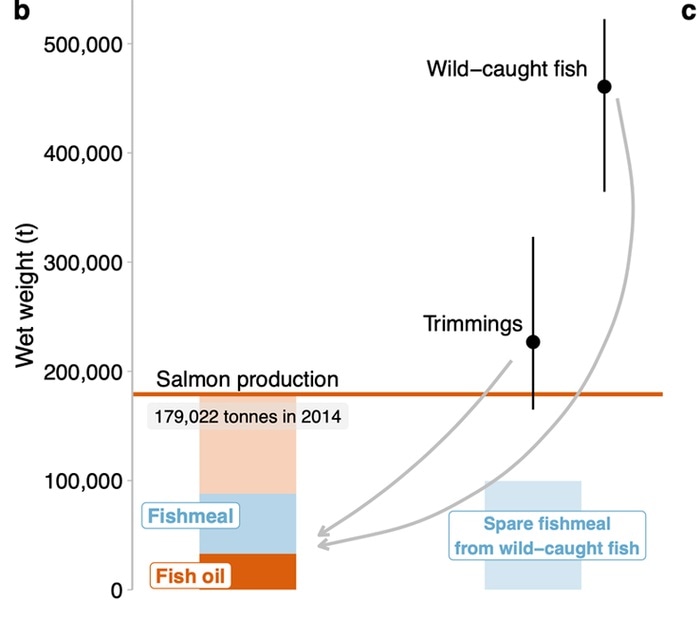Farming Atlantic salmon necessitates a large amount of wild-caught fish as feed, but it only accounts for a small portion of the world’s farmed fish production.

Panel (b) demonstrates how 2014 production used 33,000 t of fish oil, which required 227,500 t of trimmings and 460,000 t of wild-caught fish. Points and uncertainty bars reflect variation in the composition of trimmings and wild-caught fish in fishmeal and fish oil (FMFO), showing the Scottish salmon estimate (lower), global average (point), and EU average (upper). Salmon production used 55,000 t of the fishmeal produced leaving 99,688 t spare. Image Credit: Willer et al., 2022, PLOS Sustainability and Transformation, CC-BY 4.0
According to a study published on March 1st, 2022, in PLOS Sustainability and Transformation by David F. Willer of the University of Cambridge in the United Kingdom and colleagues, redirecting wild-caught fish to human consumption rather than salmon farming could alleviate the pressure on fish stocks while boosting seafood production.
Aquaculture has grown in response to increased demand for seafood. However, 90% of commercial fish feed is manufactured from human-edible fish such as sardines and anchovies. To assess aquaculture efficiency in terms of net nutrient production, scientists first calculated the volume of micronutrients and wild fish retained by fish-fed farmed salmon using data from Scotland’s farmed salmon production in 2014.
They estimated the quantity of micronutrients used as aquaculture inputs and contrasted it to the nutrient outputs of salmon aquaculture. Using this information, the researchers created models of various seafood production instances to determine the possible sustainability benefits of alternative seafood structures.
According to the researchers, 460,000 tons of wild-caught fish were used to generate 179,000 tons of Scottish salmon in 2014. 76% of the wild-caught fish were edible to humans. The data also indicate that a variety of additional seafood production models would be more effective in terms of net nutrient production, potentially reducing wild fish collection while increasing global seafood supply.
However, these data were only available for one year (2014). Future research is necessary to understand how to implement a global transition away from farmed fish and more towards sustainable fisheries.
According to the authors, “Feed production now accounts for 90% of the environmental footprint of salmonid production. Allowing salmonid production to expand further via its current approach will place exceptional stress on global fish stocks already at their limit.”
“Our results suggest that limiting the volume of wild-caught fish used to produce farmed salmon feed may relieve pressure on wild fish stocks while increasing supply of nutritious wild fish for human consumption,” they added.
The authors also commented, “Nutritious fish stocks are being squandered by salmon farming. Scientists reveal that eating the wild-caught fish destined for salmon farms would allow nearly 4 million tons of fish to be left in the sea while providing an extra 6 million tons of seafood.”
Source:
Journal reference:
Willer, D. F., et al. (2022) Maximizing sustainable nutrient production from coupled fisheries-aquaculture systems. PLOS Sustainability and Transformation. doi.org/10.1371/journal.pstr.0000005.